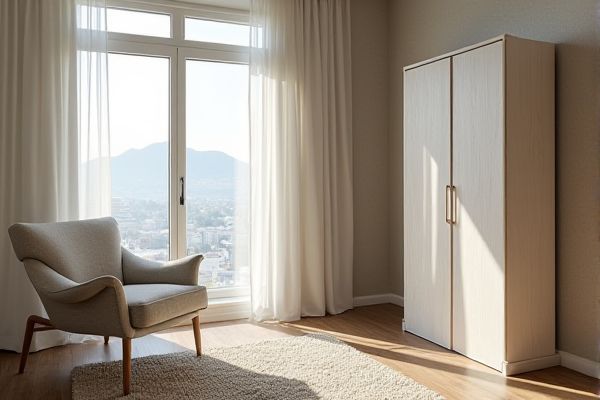
A dust cover is designed to protect individual clothing items from dust and moisture during long-term storage, while a garment bag offers full coverage and portability for transporting multiple outfits, often with additional compartments. Discover which option best suits Your needs by reading the rest of the article.
Table of Comparison
| Feature | Dust Cover | Garment Bag |
|---|---|---|
| Primary Use | Protects clothes from dust and dirt when stored | Protects and transports clothes, especially suits and dresses |
| Material | Lightweight fabric or plastic | Durable fabric, sometimes waterproof or padded |
| Protection Level | Shields from dust and light dirt | Shields from dust, dirt, moisture, and wrinkles |
| Portability | Not designed for travel | Designed for travel and easy carrying |
| Closure Type | Open bottom or simple flap | Zipper or full closure |
| Typical Size | Varies but generally covers hanging clothes | Large enough to hold suits, dresses, and multiple items |
| Cost | Generally low cost | Moderate to high cost depending on features |
Understanding Dust Covers and Garment Bags
Dust covers provide lightweight protection against dust and dirt, ideal for short-term garment storage, while garment bags offer robust protection with waterproof and breathable materials suitable for travel and long-term storage. Garment bags usually feature zippers, handles, and compartments, enhancing convenience and organization for delicate clothing items. Choosing between dust covers and garment bags depends on the level of protection and portability required for preserving garments.
Material Differences: Dust Cover vs Garment Bag
Dust covers are typically made from lightweight, non-woven polypropylene or cotton fabric designed to protect clothing from dust and light exposure, offering breathability but limited moisture resistance. Garment bags often utilize thicker, durable materials such as nylon, polyester, or PVC, providing enhanced protection against moisture, odors, and physical damage during travel or storage. These material differences influence durability, protection level, and suitability for various storage or transport needs.
Protection Level: Which Shields Best?
Dust covers provide basic protection against dust and minor dirt accumulation, making them suitable for short-term storage. Garment bags offer superior protection by shielding your clothing from moisture, odors, and potential physical damage, ideal for extended storage or travel. Choosing a garment bag ensures your clothes maintain pristine condition, especially if you need reliable defense against various environmental factors.
Breathability and Airflow Comparison
Dust covers typically offer basic protection against dust but have limited breathability, often made from plastic or non-woven materials that trap moisture and restrict airflow. Garment bags are designed with breathable fabrics like cotton or mesh panels, allowing better air circulation which helps prevent mold, mildew, and odor buildup. The enhanced airflow in garment bags prolongs fabric life by maintaining a dry environment, making them more suitable for long-term storage of delicate clothing.
Storage and Space Efficiency
Dust covers are lightweight and compact, offering efficient storage for single garments by protecting against dust and minor damage without taking up much space. Garment bags provide more comprehensive protection, including water resistance and multiple compartments for organizing several outfits or accessories, making them ideal for travel or long-term storage. Your choice depends on whether you prioritize minimal space usage with basic protection or more robust storage and organization capabilities.
Suitability for Travel: Dust Cover or Garment Bag?
Garment bags offer superior suitability for travel due to their durable materials, multiple compartments, and ability to protect clothes from wrinkles, dirt, and moisture during transit. Dust covers primarily serve as lightweight protective barriers for storage, lacking handles or compartments, making them less practical for travel. For frequent travelers, garment bags provide organized, secure, and convenient garment protection compared to dust covers.
Cost Comparison: Budgeting Your Choice
Dust covers are significantly more affordable, typically costing between $5 to $15, making them ideal for budget-conscious consumers seeking basic garment protection. Garment bags, priced from $20 to over $100 depending on material and features, offer enhanced durability and storage options but require a higher investment. Choosing between dust covers and garment bags depends on balancing minimal costs against long-term garment preservation needs.
Longevity and Durability Factors
Dust covers, typically made from lightweight materials like polypropylene or polyester, offer basic protection from dust and dirt but generally lack durability for long-term garment storage. Garment bags constructed from heavier-duty fabrics such as nylon, leather, or canvas provide superior longevity by resisting tears, moisture, and environmental damage, ensuring garments remain in pristine condition over extended periods. The reinforced seams and zippers of quality garment bags further enhance durability compared to the often fragile closures of dust covers.
Best Uses for Dust Covers vs Garment Bags
Dust covers protect delicate fabrics from dust, dirt, and moisture, making them ideal for long-term storage of seasonal clothing or formalwear. Garment bags offer enhanced portability and protection against wrinkles, perfect for travel or storing suits and dresses you frequently wear. Your choice depends on whether you prioritize stationary storage or convenient transport of your clothing.
Choosing the Right Option for Your Wardrobe
Dust covers offer lightweight protection against dust and dirt, ideal for short-term storage of delicate garments or seasonal clothing. Garment bags provide comprehensive coverage with added features like waterproof materials and compartments, making them perfect for travel or long-term wardrobe preservation. Selecting the right option depends on your wardrobe's specific needs, storage duration, and environmental factors.
 homyna.com
homyna.com